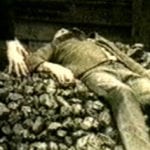 Weird Stuff
Weird Stuff  Weird Stuff
Weird Stuff  Mysteries
Mysteries 10 Tragic Disappearances and Deaths in Joshua Tree National Park
 History
History 10 Ways Childhood Really Sucked in the Old West
 Music
Music 10 Name Origins of Famous Bands from the 1990s
 Religion
Religion 10 Biggest Turnarounds by the Catholic Church
 Weird Stuff
Weird Stuff 10 Unbelievable Times Laws Had Unintended Consequences
 Humans
Humans Ten Historic Women Who Deserve Way More Credit Than They Got
 Movies and TV
Movies and TV 10 Films That Spawned Major Lawsuits
 History
History Ten Times Towns Were Wiped Off the Face of the Earth
 Creepy
Creepy 10 of the Most Disturbingly Haunted Public Houses in the UK
 Weird Stuff
Weird Stuff 10 Niche Subcultures That Are More Popular Than You Might Think
 Mysteries
Mysteries 10 Tragic Disappearances and Deaths in Joshua Tree National Park
 History
History 10 Ways Childhood Really Sucked in the Old West
Who's Behind Listverse?

Jamie Frater
Head Editor
Jamie founded Listverse due to an insatiable desire to share fascinating, obscure, and bizarre facts. He has been a guest speaker on numerous national radio and television stations and is a five time published author.
More About Us Music
Music 10 Name Origins of Famous Bands from the 1990s
 Religion
Religion 10 Biggest Turnarounds by the Catholic Church
 Weird Stuff
Weird Stuff 10 Unbelievable Times Laws Had Unintended Consequences
 Humans
Humans Ten Historic Women Who Deserve Way More Credit Than They Got
 Movies and TV
Movies and TV 10 Films That Spawned Major Lawsuits
 History
History Ten Times Towns Were Wiped Off the Face of the Earth
 Creepy
Creepy 10 of the Most Disturbingly Haunted Public Houses in the UK
10 Haunting Small-Town Murder Mysteries
A stereotype about small towns is that they’re so safe that the citizens keep their doors unlocked. Murders, especially random acts of violence, are more of an urban problem. But some small towns are so haunted by an unsolved murder that it has forever changed their landscape.
10 The Saxtown Ax Murders

Saxtown is a small town outside of Millstadt, Illinois, and it was made up of mostly German immigrants. It is also home to a gruesome unsolved murder that took place during the night of March 19 and the morning of March 20, 1874.
It is believed that someone knocked on the door of the Stelzriedes’ farmhouse, and when Fritz Stelzriede responded to the knocks, he was killed with an ax. From there, the killer went through the house and killed Fritz’s father (Frederick), his mother (Anna), his grandfather, his three-year-old brother, and his eight-year-old sister. All of them were killed with an ax, and a few also had their throats slit. A neighbor found the bodies on the afternoon of March 20. He’d come over to check on the Stelzriedes since he hadn’t seen anyone working on the farm that day.
One theory regarding the motive was that the grandfather had hidden money and gold in the house. No money was found after the murders, but there was no way to know if money had been in the house in the first place.
Another theory was that Frederick Boeltz, who was married to Anna’s sister, killed the Stelzriede family to either collect their inheritance or to ensure that he and his wife would get an upcoming inheritance meant for the Stelzriedes. Boeltz moved to Nebraska after the murders, changed his name, and was never charged with the murders.
The third theory is based on the strength of the ax swings, which were quite powerful. It’s possible that a disgruntled farmhand, who had experience using an ax, slaughtered the six family members.
9 The Be-Lo Murders
Just after 6:00 PM on June 6, 1993, an armed assailant entered the Be-Lo grocery store in Windsor, North Carolina, as the store was closing for the night and surprised the six employees inside. He led all the employees to the meat-cutting room, where he bound their wrists with duct tape. He then stacked the employees in three separate piles and shot at the stacks of people until he ran out of bullets. After unloading his gun, the man grabbed a meat cleaver and slit the throat of one person and then stabbed other bodies until the knife broke off in a victim’s back. After the rampage, which was described as “methodical,” the man left all six employees to die. Amazingly, one of the victims was able to get free and called 911. The robbery left three people dead and two injured. One person miraculously survived unharmed.
The crimes shocked the town of Windsor, which had a population of less than 4,000 people at the time of the murders. The case remains unsolved despite the surviving victims being able to give a description of the murderer. He was described as a black male, about 30–35 years old, with a narrow-bridged nose that was possibly the result of a sports injury. There is a $30,000 reward for information, and police hope that someone will come forward.
8 Nicole Lee Hattamer

On the night of December 26, 1989, 10-month-old Nicole Lee Hattamer disappeared from her crib in her grandparents’ home in Holcombe, Wisconsin. The baby’s teenage mother, her grandparents, and the mother’s younger brother and sister were all at home at the time. No one could find the baby. The family called 911, and first responders searched the area. Shortly after midnight, the baby’s frozen body was found lying face-down, 22 meters (72 ft) from the house in the backyard. Nicole obviously didn’t make it out there by herself.
An autopsy was performed, showing that the infant died from a either a chest injury or exposure. The police believe that the chest injury was caused when Nicole was thrown several feet and landed on her chest, which caused internal bleeding. The police also believe that the infant died outside because she was holding a single blade of grass.
The unsolved murder haunted the community, which only had a population of 920 people. The FBI investigated the crime in 1992 but didn’t turn up any leads. There were also two John Doe hearings, one in April 1990 and another in December 1998. John Doe hearings are special hearings to gather information for an active investigation, and the only people in the court are the judge, the prosecutor, the court reporter, the witness, and the witness’s attorney. Also, the witness’s attorney is not allowed to aid the witness.
At the trial in 1990, Nicole’s grandparents, Lou Ann and Lee Hattamer, pleaded the fifth on some questions. Also, the retired sheriff who worked on the case said that he found it puzzling that no one from the Hattamer family had ever called the sheriff’s department to check on the progress of the case.
The police believe that the only way the crime will be solved is if someone confesses or comes forward with new information.
7 The Grande Prairie Killings

On June 20, 1918, in Grande Prairie, Alberta, a town with around 1,000 people, a local discovered that the house shared by Joseph Snyder and his son, Stanley, was on fire. After the fire subsided, police found both Snyders inside. They had been shot, and there was a .38-caliber revolver lying near Joseph.
At first, it was believed to be a tragic murder-suicide. That changed four days later, when people noticed a strange smell at Ignace Patan’s farm, 7 kilometers (4 mi) away. A group of men went to investigate, and they found the dead bodies of Patan, Minister Frank Purzychowsky, and trappers Charles Zimner and John Wudwand. Patan’s throat had been slit, but the other three men had all been shot in the head. It turned out that the gun used to kill the Snyders actually belonged to Patan, meaning that the killer slaughtered everyone at the Patan farm before moving on to the Snyders. What was truly amazing about the murders was that the killer only fired five shots. Every single one was a kill shot.
The motive behind the killings at the Patan farm was most likely robbery. Patan and Wudwand had just withdrawn $5,000 from the bank to purchase a ranch. After the murder, only $108 was found. Then, in September, bloody bills started to get into circulation in Grande Prairie, and they all came from the bank in the town, but the teller couldn’t remember who had brought in the bloody bills.
The neighbor who discovered the bodies of the Snyders was the only one ever charged with the crimes, but with no evidence against him, he was acquitted in less than an hour.
6 Beverly Jaye Potter-Mintz

At around 12:00 PM on February 23, 1987, Beverly Jaye Potter-Mintz’s mother, Loren Potter, stopped by Beverly’s house in Leland, North Carolina, which had a population of less than 2,000 people. When she got there, she found her daughter’s door unlocked, which she thought was rather strange. Potter entered the house and heard her grandson crying in the back room. She went to Beverly’s bedroom and found her 23-year-old daughter, bound and motionless on her bed. Her head was covered in a pillowcase, and the room was splattered with blood. Potter removed the pillowcase and discovered that her daughter’s throat was slit to the point of decapitation. Potter grabbed her grandson and fled the house.
The police arrived at the gory scene and determined that Beverly had been raped before she was murdered. They interviewed Beverly’s son, who was home at the time, and he said that someone had knocked on the door. Beverly looked through the peephole, but there was no one there. When she opened the door, a white man, whom the son didn’t recognize, burst through the door and attacked Beverly.
There are two theories on what happened to Beverly: The first was that the killer found her through a classified ad. At the time, the local newspaper had a promotion where people could run one ad for one week at no charge. The week before the murder, Beverly had run an ad trying to sell a water bed. When it didn’t sell, she ran another ad using her mother’s phone number so she could again take advantage of the free ad promotion. On the morning of her murder, Beverly’s mother called her at about 9:30 AM to say that a man was coming by to look at the bed. At the crime scene, the police found a newspaper with Beverly’s ad circled in red. The police believe that the killer brought it with him and left it behind.
Other investigators disagree and think the classified ad might have been a ruse. They believe that Beverly was stalked because the killer knew there wasn’t a man in the house, and he brought rope and a weapon with him to the crime scene. Also, it’s believed that he was a stranger, which is why Beverly’s son was left alive.
Throughout the years, a number of suspects were investigated, but all of them had solid alibis. The case remains cold.
5 Mary Ann Holmes
On July 9, 1995, Mary Ann Holmes, a 29-year-old single mother of two, held a yard sale at her home in Thatcher, Arizona, which had a population of roughly 4,000 at the time. During the yard sale, Holmes spoke openly about how good an idea it was because of how much money she made.
The next morning, Holmes’s four-year-old daughter ran to a neighbor’s house. She was bound and naked, and she said her mother was dead. The police were called. They found Holmes murdered in her bedroom. The killer had handcuffed Holmes and then used a large knife or hatchet to strike Holmes in the head until she was dead. It was believed that he sexually assaulted Holmes after her death. Sadly, Holmes’s daughters were bound and forced to watch the entire attack.
Over the course of the investigation, 75 people were interviewed, including an ex-boyfriend who stalked Holmes, but the case went cold. In 2013, the TNT television show Cold Justice examined the case and had the DNA evidence that was left behind tested. Unfortunately, it yielded no suspects. What they do know about the killer is that he was methodical because he brought the ropes, the handcuffs, and his weapon with him. The only description that Holmes’s four-year-old daughter could give of the man was that he was large and that he was a “lion.” Police are unsure if that means he had long hair, like a lion’s mane, or if he had a lion tattoo.
4 Georgia Jane Crews

At around 5:30 PM on April 8, 1980, 12-year-old Georgia Jane Crews walked out of her home in Montverde, Florida, a tiny town with a population of 397 people. When the fifth grader didn’t return home, her family, the police, and volunteers scoured the area for her. Two days after she went missing, the county sheriff’s department received a call from a man who said, “You know that 12-year-old girl you’re looking for? She’s dead.” He then hung up.
The man made two similar phone calls. One was made to Georgia’s grandmother and the other to the wife of Montverde’s police marshal. The caller’s claims would be confirmed eight days later, when Georgia’s decomposing body was found about 40 kilometers (25 mi) away in a sparsely wooded area in a park behind a Kmart. She was wearing the same clothes she’d gone missing in, and there were no signs of sexual assault. She had died as a result from a single stab wound to the back.
The unsolved murder of a young girl is enough to shock any community. What was even more troubling was that pretty much everyone in town knew each other, and there were no strangers or strange vehicles spotted in the area at the time of the kidnapping. This has led to speculation that Georgia’s killer may have been a resident.
Unfortunately, the phone calls were never traced, and the recording of the call made to the police department was lost. There is also very little physical evidence, and police believe that the only way the crime will be solved is if someone comes forward with new information.
3 Holly Piirainen And Molly Bish
On August 5, 1993, 10-year-old Holly Piirainen and her brother were visiting their grandparents in Sturbridge, Massachusetts, which had a population of no more than 10,000 people. While there, they went to a neighbor’s house to see some puppies. They got separated, and only her brother returned to the grandparents’ cottage. The area was quickly scoured, but the only trace they found of Holly was a shoe. Her body wouldn’t be found until October 23, less than 16 kilometers (10 mi) away from where she was kidnapped. Hunters found her body in a wooded area off a rural road.
The disappearance and the discovery of the body reverberated throughout Massachusetts due to the senselessness and randomness of the crime. One person who reached out to the Piirainen family was 10-year-old Molly Bish from the nearby town of Warren, Massachusetts. She wrote them a letter when Holly was missing, which said, “I am very sorry, I wish I could make it up to you. Holly is a very pretty girl. She is almost as tall as me. I wish I knew Holly. I hope they found her.”
In a strange twist of fate, on June 27, 2000, when Molly was 16, she was working as a lifeguard at a pond near Warren, and she disappeared after her mother dropped her off. Despite a massive search and a lot of media attention, Molly’s skeletal remains weren’t found until June 2003. Due to the state of the body, it was impossible to tell the cause of death, but they do know that she was buried in a shallow grave 8 kilometers (5 mi) away from her home in a wooded area.
Besides the letter, the girls being kidnapped from the same region of Massachusetts, and their bodies being found in similar dumping grounds, it’s unclear if the two murders are connected. That being said, they do share some prime suspects.
In 2012, a man named David Pouliot was linked to Holly’s murder. He had a criminal record involving with drugs, but he didn’t have a history of violence or sexual offenses. Investigators claimed to have DNA evidence showing that Pouliot was in the area at the time of the kidnapping, but the evidence didn’t definitively link him to the kidnapping or the murder. Unfortunately, the police were never able to ask Pouliot about the DNA evidence because he passed away from natural causes in 2003.
Two brothers, Rodney and Randy Stanger, are also suspects. Rodney was a suspect in Molly’s death, and Randy is a prime suspect in Holly’s murder. Rodney is currently serving 25 years for stabbing his girlfriend to death in February 2008. A final suspect in both murder cases was Gerald Battistoni, who was camping in the area at the time of the murders. He never confessed to the murders, and he died in 2014.
Despite a few strong suspects, no one has ever been charged with either crime.
2 The Kunz Family

In 1987, the Kunz family comprised six of the 950 citizens of Athens, Wisconsin. The family was a rather unusual one, to put it mildly. They were a reclusive group that consisted of four elderly siblings who’d never married and had lived in the farmhouse their whole life. They were Irene (age 82), Clarence (age 76), Marie (age 72), and Helen (age 70). The other two members of the Kunz family were Helen’s sons, Kenneth and Randy. Randy lived in the house and was around his mother a lot, while Kenneth lived in a trailer beside the house.
On the morning of July 4, Kenneth made a horrific discovery: Irene, Clarence, Marie, and his 30-year-old brother Randy were all dead. They had all been shot two times in the head with a .22-caliber rifle. Helen was missing.
When the police arrived at the house, they found that the farmhouse had no indoor plumbing, and a lot of the cooking was done on a wood stove outside. The Kunzes were hoarders, and their place was packed with garbage. There was also a lot of money stashed throughout the house, $20,000 in all. This made it difficult for the police to be sure that the motive was robbery because there was no way to know how much money was originally in the house.
While Helen was missing, she was considered a suspect because she’d bought .22-caliber ammunition weeks before the murders, and she’d complained to the owner of the hardware store that she was mad at her family for watching “dirty movies.” Randy supposedly ordered the VHS tapes, and Helen had paid for them.
Some strange family history also came to light while Helen was missing: In 1905, the four Kunz siblings’ grandmother was murdered by her son, J. Wenzel Kunz. He was committed to a mental institution after the murder. Then, in 1932, when Helen was 15, she got pregnant with Kenneth, and the Kunz family said that their neighbor, Frank Gumz, a 40-year-old convicted bootlegger, raped her. He was convicted and sentenced to 18 months, and he died shortly after serving his sentence. At his trial, Gumz’s defense lawyer said that he wasn’t the father and insisted that Helen’s brother, Clarence, was the actual father. Witnesses said that Helen and Clarence were inseparable, and in interviews after the killings, Kenneth said that his father was Clarence. He wasn’t sure who Randy’s father was.
As the oddness around the case grew, the police were sure that if they found Helen, it would clear up a lot of the mystery. But when she was found, it only confounded things. Nine months after the massacre, Helen’s body was found buried in a swamp 28 kilometers (17 mi) away.
The only person charged in relation to the murders was 23-year-old Chris Jacobs III. He was charged with being a party to the murders in 1989. Police believed that Jacobs helped at least one other person carry out the murders. Jacobs didn’t have an alibi for 10:30 PM, which was the approximate time of the murders, and tire tracks found at the family’s farmhouse were similar to the tires on Jacobs’s car. He also owned a .22-caliber rifle. Finally, Jacobs supposedly knew that the family might have money because he’d purchased his car from Kenneth years before the murder, and he’d apparently seen an envelope full of cash.
Jacobs’s lawyers argued that while he didn’t have an alibi, he was home by 11:00 PM on the night of the murder, meaning that he couldn’t have driven Helen out to the swamp, killed her, buried her, and driven home within half an hour. As for the gun, Jacobs did own .22-caliber rifles, but none of the guns in his possession were the murder weapon, which was never found. Jacobs was ultimately acquitted of the murders.
Then, in 1993, on the day before the statute of limitations was to run out, the district attorney charged Jacobs with the kidnapping of Helen. Jacobs’s lawyers argued it was double jeopardy, but the court ruled that he had only been tried for the murders and not the kidnapping. At his kidnapping trial, which used all the evidence gathered in the murder investigation, his ex-girlfriend, Stacy Weis, said that Jacobs confessed to killing the Kunzes. Weis only came forward after she was arrested in connection with a bank robbery and home burglary in Minnesota. This time, Jacobs was found guilty and sentenced to 31 years in prison, the maximum sentence for kidnapping.
Jacobs has always maintained his innocence, and no one has ever been convicted in connection with the murder of the members of the Kunz family.
1 Gregory Villemin

Lepanges-sur-Vologne is a small village in northeast France with a population of less than 1,000 people. It is also home to one of the most brutal unsolved mysteries in the history of modern France.
On October 16, 1984, the uncle of four-year-old Gregory Villemin received a call saying that Gregory had been kidnapped and murdered. Immediately, Gregory’s parents and the police were alerted. Shortly after the call, the body of the four-year-old was found floating in the Vologne River about 7 kilometers (4 mi) away from his home. Gregory’s hands and feet were bound, and he had drowned. The day after the murder, Gregory’s parents received a letter in the mail that read, “I hope you die of grief, boss. Your money can’t give you back your son. Here is my revenge, you stupid bastard.” The letter had been sent the day of the murder from the post office in town.
Gregory’s parents, Christine and Jean-Marie Villemin, knew who was responsible for the murder, but they didn’t know his true identity. It was a mysterious man whom the media nicknamed “The Crow.” The Crow had been harassing the Villemins for at least three years before the murder by making obscene and threatening phone calls. The couple even recorded some of the phone calls, but the voice was never identified.
There were a number of suspects in the case. The first was Bernard Laroche, Jean-Marie’s cousin. In February 1985, Laroche was cleared of all charges, which infuriated Jean-Marie. While speaking with journalists, Jean-Marie vowed that he would kill his cousin. True to his word, he shot Laroche to death on March 29 as Laroche was leaving work. Jean-Marie was convicted and sentenced to five years in prison.
Gregory’s mother, Christine, was also a suspect in the murder. She was seen at the post office on the day of the murder, cords similar to those used to bind Gregory were found in the family’s basement, and the handwriting analysis from the letter implicated her. She was even held as a suspect in July 1985, but then a judge forbade any prosecution of her, a rare move.
Another interesting fact about the case is that there is plenty of DNA evidence, including saliva left on the stamp and DNA left on the cords. When the cords were tested in 2013, the results were inconclusive, which makes the likelihood of finding the identity of the Crow and the killer at the heart of “Affaire de Gregory” very unlikely unless someone comes forward with new information or clues.
Robert Grimminck is a Canadian freelance writer. You can friend him on Facebook, follow him on Twitter or on Pinterest, or visit his website.







![Top 10 Haunting Images Of Historic Tragedies [DISTURBING] Top 10 Haunting Images Of Historic Tragedies [DISTURBING]](https://listverse.com/wp-content/uploads/2020/05/33758v-150x150.jpg)
